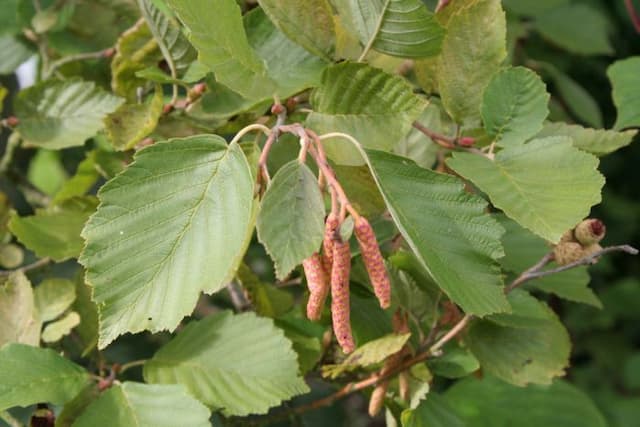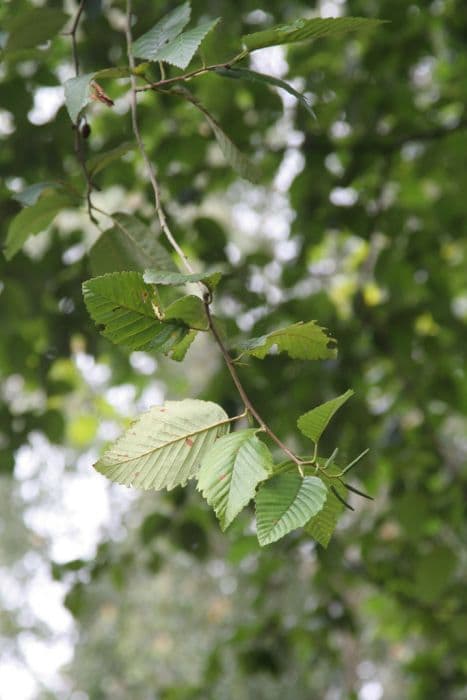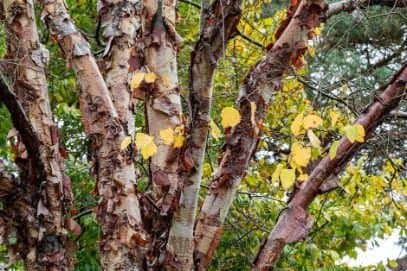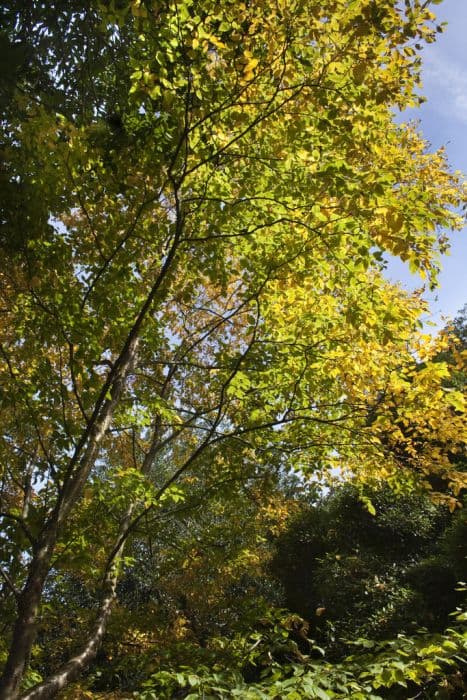Himalayan Birch Betula utilis subsp. jacquemontii 'Inverleith'

ABOUT
The plant commonly known as the white-barked Himalayan birch 'Inverleith' is renowned for its striking appearance, primarily due to its distinctive bark. The bark is a brilliant, snowy white that peels off in sheets, showcasing a clean and bright surface that can be almost luminescent, especially in winter months when contrasted against darker surroundings. Its leaves are small to medium-sized, oval to ovate in shape with a pointed tip and a toothed margin. During the growing season, the foliage presents a lush, vibrant green color that is both fresh and lively. In autumn, the green leaves transition to a rich yellow, providing a striking, warm contrast to the paler bark. As a cultivar, 'Inverleith' often bears more compact and evenly arranged branches than other varieties. The branches arc gracefully, holding the leaves in a pattern that creates an attractive overall canopy structure. This dense, leafy canopy produces dappled shade beneath it during sunny days. On closer inspection of the branches, observers may find delicate catkins. These pendant structures add visual interest with their subtle texture and contrast beautifully against the foliage. Overall, the white-barked Himalayan birch 'Inverleith' is a plant of exceptional beauty. Its ghostly white bark and verdant leaves provide a visual appeal that can be appreciated in a variety of settings, from structured gardens to more natural landscapes.
About this plant
 Names
NamesFamily
Betulaceae.
Synonyms
West Himalayan Birch, Jacquemont's Birch, Whitebarked Himalayan Birch, Kashmir Birch.
Common names
Betula utilis var. jacquemontii, Betula jacquemontii.
 Toxicity
ToxicityTo humans
The Himalayan birch is generally considered non-toxic to humans, and there are no known toxic effects from ingesting parts of this plant. It is commonly used in landscaping and horticulture without any specific concerns for human health.
To pets
The Himalayan birch is not known to be toxic to pets. It is generally safe for animals, and there are no significant risks associated with pets ingesting parts of this plant.
 Characteristics
CharacteristicsLife cycle
Perennials
Foliage type
Deciduous
Color of leaves
Green
Height
20 feet (6 meters)
Spread
15 feet (4.5 meters)
Plant type
Tree
Hardiness zones
7
Native area
Himalayas
Benefits
 General Benefits
General Benefits- Aesthetic Appeal: Betula utilis subsp. jacquemontii 'Inverleith', commonly known as Himalayan Birch, is highly prized for its striking white bark, which adds a strong visual element to landscapes.
- Wildlife Habitat: It provides shelter and nesting sites for various bird species, while its catkins serve as a source of food for wildlife.
- Shade and Cooling: The canopy of the Himalayan Birch offers shade, creating a cooler microclimate beneath it, which can be beneficial in gardens and parks.
- Erosion Control: The tree's root system helps stabilize the soil, preventing erosion, especially on slopes or in areas with loose soil.
- Seasonal Interest: Its seasonal changes, including spring catkins, summer foliage, autumn color, and striking winter bark, provide year-round visual interest.
- Cultural Significance: The Himalayan Birch may be used in cultural or traditional practices, including ornamental uses in gardens and parks.
- Diversity in Planting: It contributes to biodiversity in landscaping by adding another species to the environment, especially when included in tree collections or arboretums.
- Low Maintenance: Once established, Himalayan Birch requires relatively little maintenance, making it suitable for public spaces and low-maintenance gardens.
 Medical Properties
Medical Properties- This plant is not used for medical purposes.
 Air-purifying Qualities
Air-purifying QualitiesThis plant is not specifically known for air purifying qualities.
 Other Uses
Other Uses- The bark of the Himalayan birch can be used as a natural paper or canvas for artists, as it has a unique texture and can be written or painted on.
- Woodworkers appreciate the uniform grain of Himalayan birch wood, which is used in making small decorative objects due to its light color and smooth surface.
- The wood of Himalayan birch, being strong and durable, can be used for making furniture, particularly in rural settings where its aesthetic is valued.
- Landscapers use Himalayan birch in xeriscaping, as it can thrive with less water once established, making it ideal for dry climate gardens.
- In colder regions, Himalayan birch trees can be planted as windbreaks to protect homes and gardens from harsh winds.
- Himalayan birch twigs and branches can be used in basketry for creating intricate woven designs, often used as decorative pieces or for light storage.
- Fallen leaves of the Himalayan birch can be gathered to create nutrient-rich mulch for gardens, providing a natural fertilizer for plants.
- The pale, reflective bark of Himalayan birch can be used in landscape design to create visual contrast, especially in winter gardens where it stands out against darker foliage or snow.
- The tree can serve as a natural habitat for a variety of bird species, who may use the branches for nesting and the bark for foraging insects.
- During celebrations like Christmas, small branches from Himalayan birch can be used as festive decorations, either on their own or as part of wreaths and centerpieces.
Interesting Facts
 Feng Shui
Feng ShuiThe Himalayan Birch is not used in Feng Shui practice.
 Zodiac Sign Compitability
Zodiac Sign CompitabilityThe Himalayan Birch is not used in astrology practice.
 Plant Symbolism
Plant Symbolism- Purity: The white bark of the Himalayan birch, which Betula utilis subsp. jacquemontii 'Inverleith' is a cultivar of, is commonly associated with cleanliness and purity, echoing its pristine and unblemished appearance.
- New Beginnings: As a tree that can pioneer in disturbed soil, the Himalayan birch symbolizes fresh starts and rebirth, reflective of its role in nature as an early successional species.
- Adaptability: Able to grow in challenging environments, this birch represents resilience and the ability to thrive in various conditions, pointing to versatility and strength.
- Protection: Historically, birch trees have been considered as protectors, with their dense wood and canopy offering shelter and their traditional use in safeguarding against evil spirits in folklore.
 Water
WaterThe Himalayan Birch should be watered deeply once or twice a week, depending on weather conditions, to keep the soil consistently moist but not waterlogged. During hot and dry periods, increase the frequency of watering to prevent the soil from drying out completely. Generally, it's recommended to provide approximately 1 to 2 gallons of water per week for a young tree, adjusting for rainfall and adjusting as the tree matures and establishes. Overhead watering or using a soaker hose at the tree's base will ensure the water reaches the root zone efficiently.
 Light
LightThe Himalayan Birch thrives in full sun to partial shade conditions. For optimal health and growth, place it in a location where it can receive at least 6 hours of direct sunlight daily. It can tolerate some light shade, but too much shade may lead to sparse foliage and a less vigorous tree.
 Temperature
TemperatureThe Himalayan Birch can tolerate a wide range of temperatures but grows best in conditions where the average temperatures are between 60°F and 75°F. It can survive winter cold down to around -20°F and summer highs up to 85°F. Avoid planting in areas with extreme heat particularly where summer temperatures consistently exceed 85°F.
 Pruning
PruningFor the Himalayan Birch, prune to remove any dead, broken, or diseased branches, to improve the tree's structure, and to maintain its aesthetic shape. Pruning should be carried out during late fall to mid-winter when the tree is dormant to minimize sap bleeding. As a general rule, prune no more than 25% of the crown at a time, and focus on cutting back to a strong lateral branch or the tree's trunk.
 Cleaning
CleaningAs needed
 Soil
SoilHimalayan Birch requires well-draining soil with a mix of loam, sand, and organic matter. Aim for a slightly acidic to neutral pH of 6.0-7.5 for optimal growth.
 Repotting
RepottingHimalayan Birch trees grown in containers require repotting every few years to prevent root bounding and to replenish nutrients in the soil.
 Humidity & Misting
Humidity & MistingHimalayan Birch thrives in average outdoor humidity levels and does not require specific humidity adjustments.
 Suitable locations
Suitable locationsIndoor
Not ideal for indoor growth due to size and light needs.
Outdoor
Plant in well-draining soil, full sun to partial shade.
Hardiness zone
5-7 USDA
 Life cycle
Life cycleThe life cycle of the Himalayan birch, specifically the 'Inverleith' cultivar, begins with seed germination, usually occurring in spring when soil temperatures increase. After germination, the seedlings establish and enter a juvenile phase, developing into young saplings with characteristic peeling white bark and serrated, downy leaves. As saplings mature into adult trees, they experience a period of vegetative growth, which may last several years, where the trees increase in both height and girth. During maturity, the Himalayan birch produces catkins, which are the reproductive structures, with male catkins releasing pollen and female catkins developing into small cones that disperse seeds. After successful pollination and seed set, the cycle continues as new seeds spread, potentially establishing new trees. The Himalayan birch may live for several decades, during which mature trees may go through multiple cycles of flowering and seed production.
 Propogation
PropogationPropogation time
Late winter to early spring
Propogation: The Himalayan birch, specifically Betula utilis subsp. jacquemontii 'Inverleith', is commonly propagated through seed sowing or semi-hardwood cuttings. However, the most popular method is through seed sowing, which is typically done in late fall or early winter. To propagate by seed, one would collect the seeds in autumn once they have matured and sow them superficially onto a well-drained, sandy compost mix. Seeds require exposure to cold temperatures for stratification, so outdoor sowing or refrigeration for several weeks can achieve this. Once the stratification period is complete, which usually lasts between 1 and 3 months, seeds can be moved to a warmer environment for germination. Care should be taken to keep the compost moist but not waterlogged, and once seedlings have reached a sufficient size, they can be potted on or planted out into their final position.









